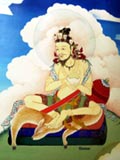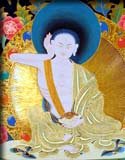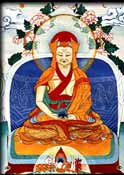
Karma Kagyu Lineage
Kagyu Lineage emphasizes on oral teaching passing down from teacher to student. It was originated with the great yogi called Tilopa who lived in Northern India around 10th century A.D. Tilopa received the transmission directly from Dorje Chang (skt.: Vajradhara), the celestial Buddha who symbolizes the Dharmakaya, the ultimate mind. Tilopa in turn gave the whispered teachings to Naropa who had previously been chancellor of Nalanda University in India.
Naropa transmitted his knowledge to Marpa, the great translator, who journeyed from Tibet to India in order to receive instructions and who subsequently returned to Tibet and where he spread the Dharma teachings. Milarepa who was then the student of Marpa became one of Tibet's great yogis. Through his perseverance in the practice of Mahamudra and the Six Yogas of Naropa, he achieved profound realization of the ultimate nature of reality.
Gampopa, a physician from Dagpo was entrusted with complete Kagyu transmission from Milarepa. He established monastic institutions, taught extensively and attracted many students. Four of his main disciples founded the four 'greater' branches of the Kagyu lineage. The eight 'lesser' divisions developed later. Gampopa passed away at the age of seventy-five, having spread the Kagyu teachings far and wide. From among his foremost disciples, Karmapa Dusum Khyenpa became the next lineage holder and he received the complete Mahamudra transmission from Gampopa.
"The Golden Kagyu Garland" refers to the master who are the holders of the lineage in which Mahamudra is a main theme. They are the Indian masters of the lineage and the successive reincarnations of the Karmapas and their most important students who pass on the transmissions to him. The lineage holders are selected by Karmapa himself which ensures that the teachings remain intact and pure.
The Karmapa himself always chooses the teacher who will pass on the lineage to him in his future incarnation. He is a great bodhisattva who has the capacity to perceive the realization and qualities of others. It is through this ability that he selects his own guru. There is no fixed rule which defines the teacher in advance. In some cases the lineage holders are eminent reincarnates and in other cases exceptional practitioners without high status in the religious hierarchy.




